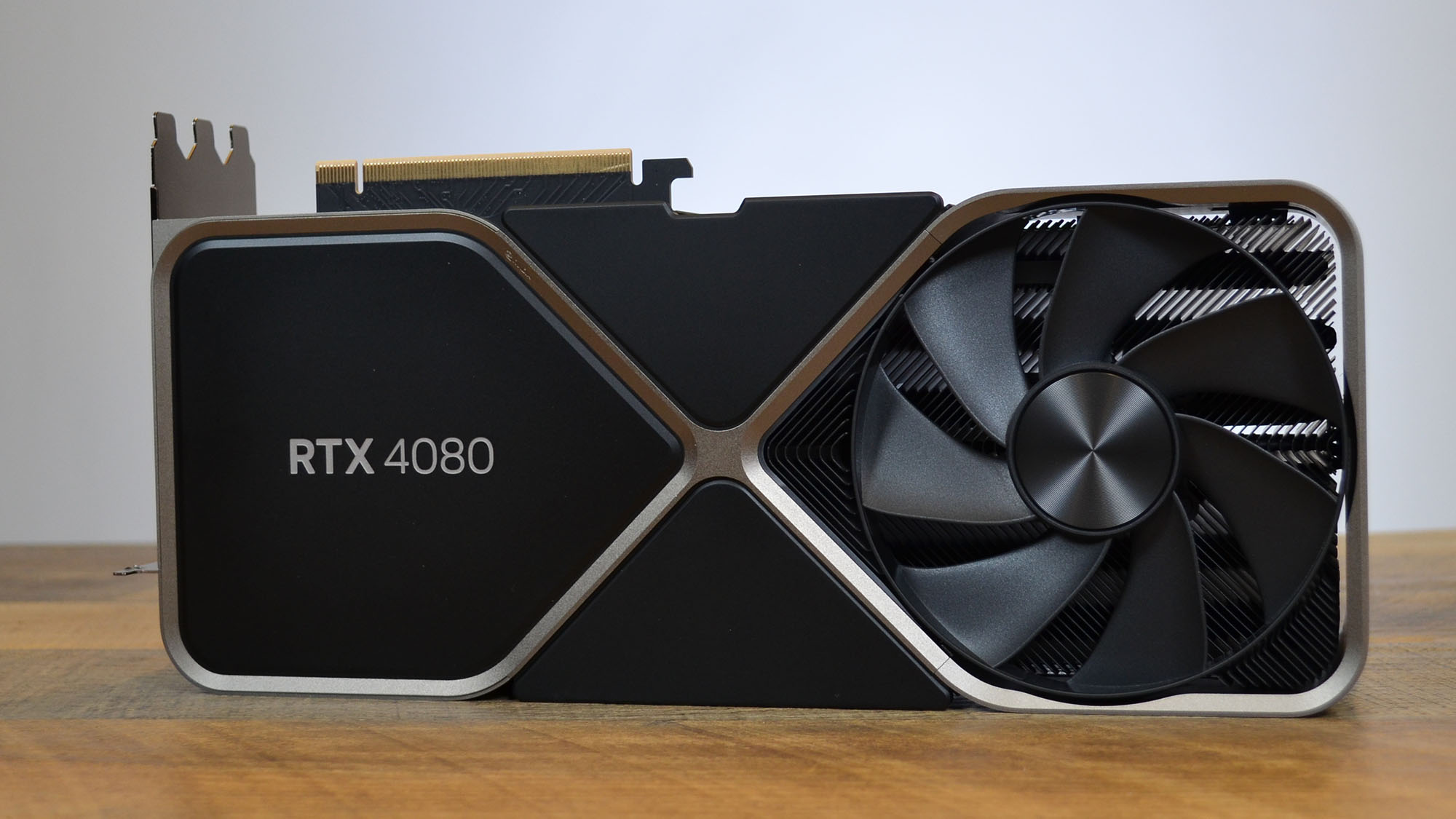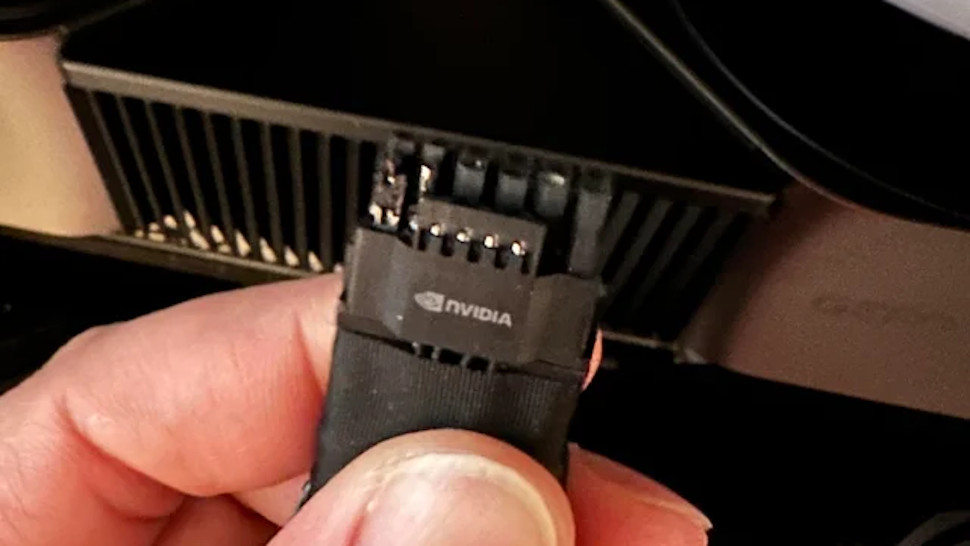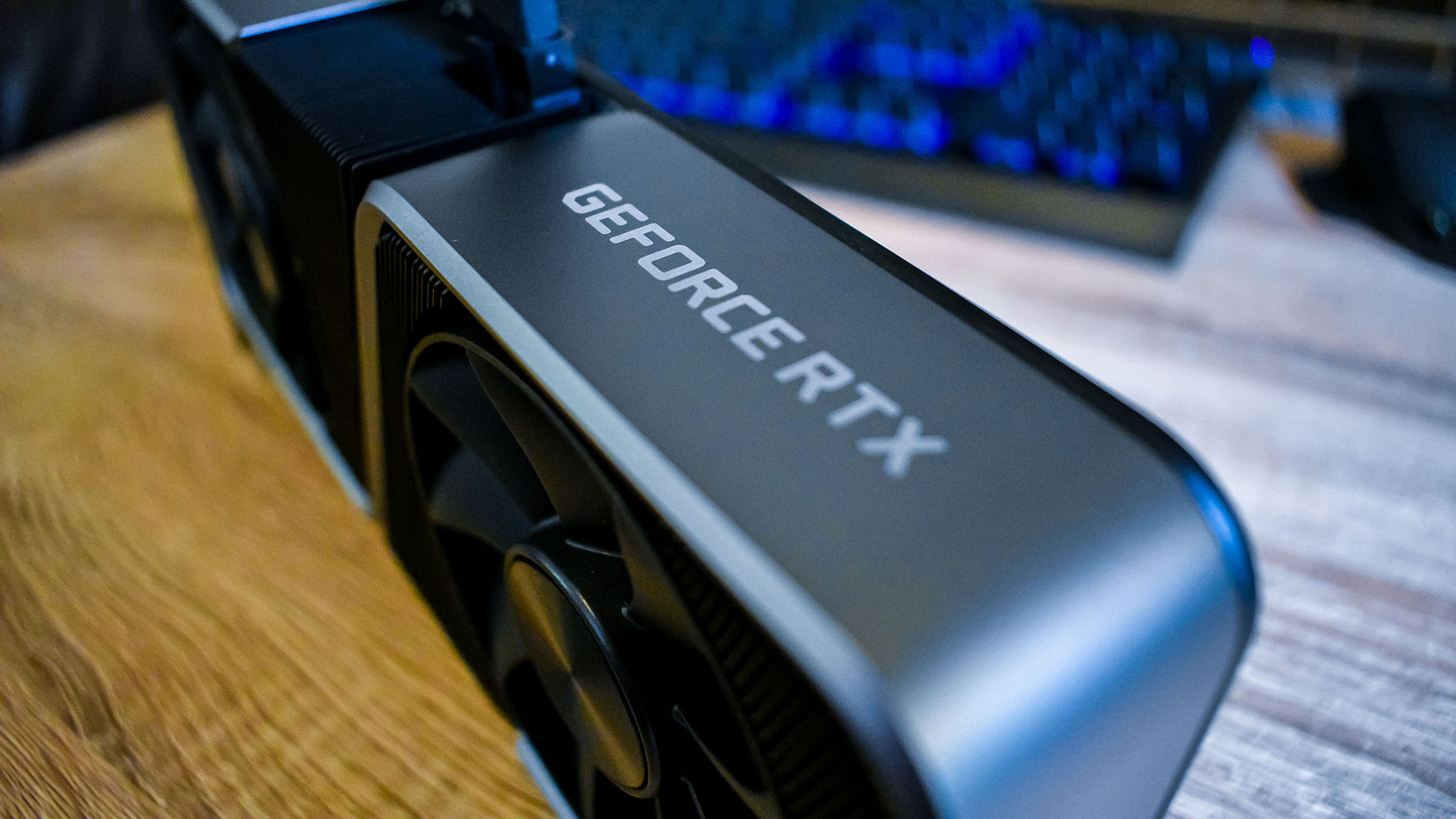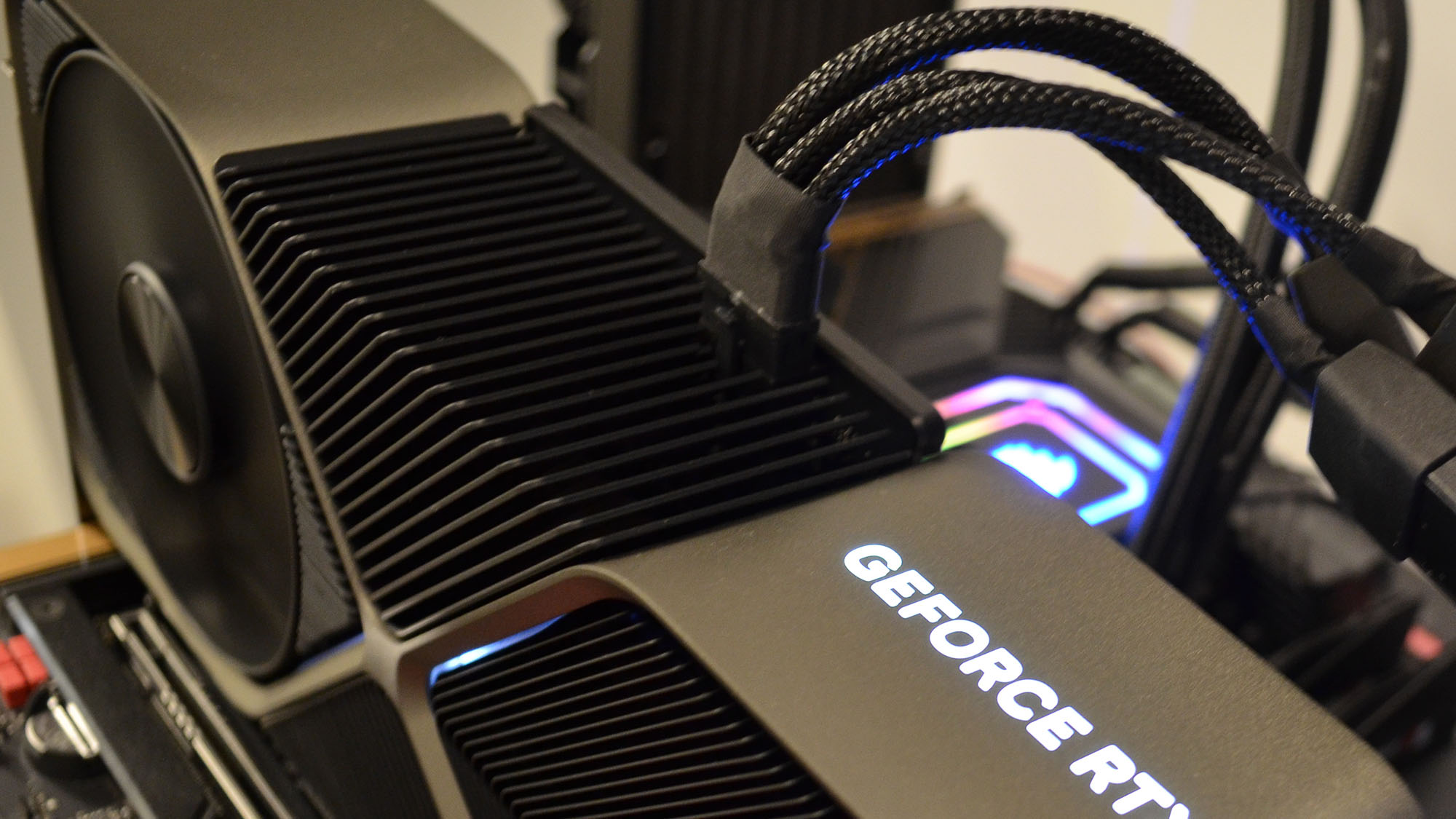Nvidia in 2022: year in review
From melting adapters to RTX remixes of old games

Over the past year, Nvidia has certainly experienced its fair share of problems and controversies, as you’re unlikely to have missed. Good things happened in 2022, certainly, but there were a fair number of bad occurrences, and even some ugly ones (melting adapters on top-end GPUs springs to mind in that category). Without further ado, let’s get cracking on summarizing Nvidia’s progress – or lack of it in some cases – during 2022.

Lovelace GPUs arrived with a superfast flagship – and some serious problems
Nvidia’s Lovelace GPUs succeeded Ampere, with the first next-gen model coming out in mid-October, the flagship RTX 4090. That was followed by the RTX 4080 a month later, and while both desktop graphics cards were undeniably fast – particularly that flagship – they were both equally undeniably dogged with some thorny problems.
Let’s start with the RTX 4090 and the case of the melting adapters. Even before the RTX 4090 came out, we knew it would be a powerful but power-hungry beast, and so it came to pass, with the flagship sporting a TGP of 450W. So, any buyers had to take care that their power supply could handle that, and that their case design could cope with the heat produced by the RTX 4090 (and that the GPU would fit inside the case in the first place, of course).
However, not long after the RTX 4090 emerged, worrying reports of melting adapter cables reached our ears. These were few in number to start with, and Nvidia was quick to say it was investigating, but gradually these complaints multiplied.
The problem was being encountered by those who used the adapter supplied with the RTX 4090 so it could be connected to an ATX 2.0 power supply. (Those PSUs are what most PC owners have, with not many folks having upgraded to the very new ATX 3.0 models. But the 4090 comes with a 16-pin power connector that works directly with ATX 3.0 PSUs, and doesn’t fit ATX 2.0 models – so with the latter, the adapter has to be used).
Unfortunately, that adapter was melting in some cases, and damaging the graphics card, too, in some of those instances. Which is obviously a terrible situation (not to mention the fire risk element, if you’re not around when the smoking begins).

Now, we should note very clearly that according to the Nvidia investigation, as of mid-November, there were only 50 cases globally. That’s 50 cards in purported sales of something like 125,000 boards, which if correct, would mean the chance of a melting adapter is very unlikely. As the big Reddit mega-thread on this issue points out, the chance of a melt being experienced is 0.04% – but still, it can happen.
Sign up for breaking news, reviews, opinion, top tech deals, and more.
There was lots of theorizing about why the adapters were melting, and the most prominent theory – that the adapter wasn’t seated properly in its socket in the GPU – was confirmed by Nvidia to be the most likely culprit. As Nvidia told us: “Our findings to date suggest that a common issue is that connectors are not fully plugged into the graphics card.”
Part of the problem here, though , is that to fit this gargantuan graphics card in your PC, you have to bend the power cable round quite tightly (maybe with it pressed up against the side panel of the case), and this could put strain on the adapter and perhaps begin to pull it out of the socket slightly.
What’ll be Nvidia’s final conclusion on this affair? We still don’t know that at the time of writing, but this has left a somewhat sour taste in the mouths of some buyers who paid a lot of money – a small fortune, in fact – for the Lovelace flagship.
However, we should make it clear that the RTX 4090 itself is a jaw-droppingly speedy high-end GPU, and an incredible performance high point, make no mistake on that (for gamers and creatives alike). But a design flaw like this, no matter how very uncommon it might be, is really quite a serious drop of the ball from Nvidia (even if the company is offering expedited returns for affected graphics cards, as you might expect). No matter how great the RTX 4090 might be in raw performance terms, this episode has still tarnished Nvidia’s reputation to an extent.

Let’s move on to the RTX 4080, which may not have suffered from melting controversies, but actually caused more of a stir than the RTX 4090 in the end – thanks to pricing, and the fact that it turned up as two variants, one of which was quickly canceled.
When Nvidia revealed the RTX 4080, two models were shown off – one with 16GB of VRAM, and the other with 12GB (and a lesser spec GPU chip). Immediately there was an outcry about the latter lower-tier model, and how relatively pants it was – for its price – and the undoubted confusion caused by having two such very different flavors of RTX 4080. Especially when one of those flavors looked suspiciously like an RTX 4070 in RTX 4080 clothing (with that theory very much underlined by RTX 4070 Ti rumors later in the year).
Following all this controversy, Nvidia famously ‘unlaunched’ the graphics card and consigned it to the dustbin. (That said, its resurrection is rumored to be imminent as the aforementioned RTX 4070 Ti, but that story will be for next year).
Price-wise, like the scrapped lower-tier model, the RTX 4080 16GB that went on sale was still a price/performance nightmare. Particularly when custom third-party boards pushed up the already exorbitant MSRP ($1,199 in the US) to dizzying heights that made them almost as costly as the RTX 4090 – which is very much a faster GPU.
So why on earth would you buy the RTX 4080, and not the flagship? That was the thinking of quite a few folks, and the value proposition of the RTX 4080 prompted us to call it the GPU that Nvidia should have canceled (referencing the aforementioned canned 4080 12GB, of course).
And going by sales estimates floating around via the rumor mill – with some pretty consistent approximations – it seems GPU buyers agreed, and RTX 4080 sales flagged, trailing the RTX 4090 by a long, long way.
All in all, the Lovelace graphics card launches for 2022 were seriously problematic in some respects, then. But this shouldn’t draw away from the fact that the RTX 4090 offered an astonishing level of frame rate shifting power – plus don’t forget DLSS 3 was added into the mix with all Lovelace cards, too (we’ll talk more about that later) – and even the RTX 4080 is a powerful GPU, make no mistake.
It’s just that the price of the RTX 4080 is way more off base than the Lovelace flagship, value-wise – which is really saying something – although Nvidia may well be about to correct that pricing according to the rumor mill. (Particularly in light of how that value proposition looks even worse compared to the freshly launched AMD RX 7900 XTX). Indeed, by the time you read this, maybe that RTX 4080 price correction could’ve already happened…
As a final note on Lovelace, another blow to Nvidia was delivered by EVGA, one of its larger graphics card manufacturing partners, which announced just before the launch of RTX 4000 GPUs that it wouldn’t be making or selling these products (amidst controversial rumors – such as “disrespectful treatment” – about why). Effectively that wound up EVGA’s operations on the graphics card front, although the firm still supports RTX 3000 boards, of which some are still on sale – which brings us onto our next point…

RTX 3000 stock still hanging around
Another issue that Nvidia faced late in 2022 was the amount of RTX 3000 graphics cards that were still on shelves or in warehouses with the RTX 4000 launch looming. That represented a problem because once Lovelace GPUs were released (or even revealed), it’d mean gamers were looking to buy (or wait for) those next-gen graphics cards – and Nvidia, or more precisely its partners, still had all that RTX 3000 stock to shift, and that’d be interfered with.
So, this meant Nvidia employed a strategy in which RTX 3000 GPUs were ‘layered on top’ of next-gen GPUs, as the company put it. In practice, this meant we got the new RTX 4090 and 4080, the weighty high-end offerings we’ve just been discussing, whereas the rest of the market remained Ampere (RTX 3070, 3060, 3050 – and the older budget offerings below that).
In short, this meant all we got from Lovelace was super-expensive GPUs, allowing breathing room for that whole range of RTX 3000 stock below to sell through. And while throughout 2022, and particularly as the year rolled on, graphics card pricing had been dropping – well, normalizing from inflated levels, and finally dropping just below MSRP eventually – that trend stopped dead in November with Nvidia cards. Sadly, RTX 3000 pricing actually rose during that month for many GeForce models, as our sister site Tom’s Hardware, which tracks GPU price tags on a monthly basis, observed, with chunky price rises (urgh) on the Nvidia front for the RTX 3090, 3080 and 3070.
Perhaps because people realized they weren’t getting an RTX 4060 anytime soon, at least not going by the grapevine – and leakage being thin on the ground – so mid-range options, or certainly mid-to-lower range, are pretty much to look at Ampere for the foreseeable.
This is what Nvidia wanted, obviously enough – to be able to clear that stock – but a pair of exorbitantly priced next-gen cards, and rising price tags on Ampere GPUs when previously the RTX 3000 series had been dropping in cost significantly, is very much not what gamers wanted. And the way this is working as intended, we presume, is likely another reason as to why we shouldn’t expect an RTX 4060 any time in the near or even medium-term future.

Budget GPU woes (again)
2022 was another year in which Nvidia neglected the budget end of the GPU market, which is an ongoing theme in the contemporary world of graphics cards, it seems.
Last year, we bemoaned the lack of an RTX 3050 at the more wallet-friendly end of the spectrum, and this year, we finally got this graphics card. Shame, then, that it turned out to be, well, not exactly a budget card, with an MSRP of $249 in the US – which might sound okay, but it’s a good chunk more than xx50 model GPUs that went before it – and you couldn’t buy the RTX 3050 at that price anyway. It’s still a fair chunk above that recommended price at the time of writing, and it was not far off double upon launch early in the year (and thin on the ground, stock-wise).
Nvidia also deployed the GTX 1630 in June, a model actually targeted squarely at the budget arena, but it was so weak sauce (plus it was well overpriced at launch, and still pricey today, for what it is) that the less said about this GPU, the better.
Those new offerings for 2022 were not a solution, then, and to heap more misery on the situation, Nvidia could be in the process of making things worse on the cheap GPU front. If the rumor mill is right – and there’s been some fairly consistent chatter on this – the RTX 2060 is being discontinued, and the same might be the case for the GTX 1660. While we must take word from the grapevine with a great deal of seasoning, if true, this would leave Nvidia’s line-up at the very cheapest end of the market looking extremely thin. And things are already shaky as it is, as mentioned.
Okay, so don’t get us wrong, the budget situation throughout 2022, particularly later on, was better than last year. Mainly because 2021 was an absolute farce, really, with gamers paying seriously silly money for the likes of a GTX 1650 Super at the budget end of the spectrum. But still, even with GPU pricing normalizing to more reasonable levels (finally), and the RTX 3050 being added to Nvidia’s roster, Team Green simply didn’t do enough here, and budget buyers remained restricted in choice, to put it mildly.
Plus, don’t forget that as we’ve already touched on, the RTX 4060 looks to be a long way off still, although how ‘wallet-friendly’ this GPU might be is entirely debatable anyway (the RTX 4050 isn’t in sight either, for that matter; laptop GPUs aside). Apparently what we’ve got for now in the somewhat-more-affordable-department is a refreshed RTX 3060 Ti (with faster VRAM) which was brought into play late in the year – and that’s not nearly enough. (Plus it’s another sign not to expect the RTX 4060 anytime soon, arguably).
Ah, well. Maybe next year will be different for budget desktop GPUs. Here’s hoping.

More frame rate boosting with DLSS 3
Nvidia DLSS, the company’s well-established upscaling tech, got a third-gen incarnation this year which was revealed in September. DLSS 3 recruited a bunch of new features (Optical Multi Frame Generation, Optical Flow Accelerator; read up more here) to further accelerate frame rates and ensure a smoother gaming experience.
There’s been some controversy around DLSS 3 and its exact use cases, along with concerns about increased latency as Techspot reported, which can impact certain games, like twitch shooters as opposed to, say, Microsoft Flight Simulator. But where it works well – with supported games, and Flight Simulator is very much a highlight here – it’s a great new tech, and another step up in terms of getting a seriously smooth frame rate.
The obvious caveats, though, are that support is thin on the ground thus far, and only RTX 4000 graphics cards need apply. Which makes DLSS 3 feel a bit like a tool that’s being used to help improve the value proposition of the super-pricey Lovelace GPUs which are out there, the cynical might suggest – although Nvidia has told us there are reasons for the tech being RTX 4000-only. (Namely that it’ll require additional research and engineering to be applied to older Nvidia GPUs, and any benefits wouldn’t be as pronounced).

Remixing old games with ray tracing
You know the saying: in with the old, and… wait a minute, that’s not right. But this was one of the bright ideas Nvidia had on the ray tracing front this year, with RTX Remix. This new tech (built on the Nvidia Omniverse platform) was revealed at GTC 2022 alongside Lovelace graphics cards, and it truly is a modder’s dream, allowing for old games to easily be given a fresh coat of RTX paint with ray tracing and DLSS.
Nvidia showed off Elder Scrolls III: Morrowind in its remastered glory at GTC, which looked very impressive indeed. The theory is that when it’s released next year, RTX Remix will allow the modding community to spruce up a whole bunch of older games, giving them a new lease of life. An exciting prospect indeed.

GeForce Now kept streaming ahead
If you couldn’t afford a new GPU, then maybe you signed up for Nvidia’s game streaming service in 2022. Those who did benefited from some solid improvements to GeForce Now, one of which was the ability to stream in 4K for those on Windows PCs and Macs. That was for those gamers on the higher-tier RTX 3080 membership, and there was another useful change with that plan – namely the ability to sign up for just a month, allowing folks to try it out for a short time and see how smoothly the fastest GeForce Now offering runs for them.
Nvidia is building a more attractive streaming option, slowly but surely, and the demise of Google Stadia this year (well, it officially closes down mid-January 2023) has helped make more breathing space in the game streaming arena, something Team Green has been trying to take advantage of, naturally.
Nvidia said farewell to ARM
Nvidia’s attempted acquisition of ARM, a huge $40 billion move, was dogged with problems from the outset. Initiated way back in 2020, the buyout ran into nothing but trouble throughout 2021, culminating in a lawsuit from the FTC to stop the deal proceeding on the grounds that it was anti-competitive. This year, in February, Nvidia finally gave up this ambition and officially terminated its bid for ARM. In the end, given all the opposition and the vehemence of those naysayers, this was hardly a surprise.

Concluding thoughts
As you made your way through this article, you may have found yourself feeling a bit depressed. A lot of what we’ve discussed here is Nvidia’s woes and missteps, and that’s inevitable, because, well, 2022 contained a fair few of them. Most obviously, sky-high pricing for new GPUs, issues around both the RTX 4090 (adapters melting) and RTX 4080 (that canceled version, plus value proposition), and more drawn-out budget graphics card misery.
And yet, to be fair to Nvidia, those Lovelace graphics cards represent some seriously impressive pieces of engineering (adapter cables aside), with the RTX 4090 being ridiculously fast, frankly (and a long way ahead of AMD’s rival RDNA 3 flagship, albeit with outliers). DLSS 3 also looks very promising (with the caveats that we mentioned) early doors, and RTX Remix is a seriously nifty idea, too.
It’s not like there weren’t positives, then, but too many clouds of negativity were blotted across the sky for Nvidia this year. But even so, guess what – Team Green is still by far the most dominant desktop GPU power. Indeed, the latest stats we have at the time of writing (for Q3 2022, from Jon Peddie Research) show Nvidia with an 88% market share of discrete graphics cards. 88%! Or what we’d call a Google level of dominance.
Is Nvidia untouchable in the desktop GPU space? Could this level of domination be the reason why the company feels confident in pricing new GPUs the way it did with Lovelace? Well, whatever the case, Nvidia better not get too confident, or comfortable on its GPU laurels, as AMD has produced a compelling offering with its RX 7900 XTX flagship – one very much capable of taking on the RTX 4080, at a lower price point (as we write this) – and there’s more to come in the RDNA 3 range, of course.
Things could start to change quite quickly if Nvidia doesn’t relent in the practice of pushing ever-dizzying premium pricing on its new GPUs, because extracting every last dollar from gamers amidst a cost-of-living crisis could leave Team Green looking at a dwindling reservoir of goodwill in terms of its public perception. Which could lead to more people turning to AMD, or maybe even Intel at the budget end of the GPU spectrum, which Nvidia still seems unwilling to address in a meaningful way.
Let’s see how 2023 starts, with the rumored RTX 4070 Ti launch supposed to be happening at CES, and if that goes ahead as predicted, then come on Nvidia: let’s have a pleasant surprise on the pricing front, for once.
Darren is a freelancer writing news and features for TechRadar (and occasionally T3) across a broad range of computing topics including CPUs, GPUs, various other hardware, VPNs, antivirus and more. He has written about tech for the best part of three decades, and writes books in his spare time (his debut novel - 'I Know What You Did Last Supper' - was published by Hachette UK in 2013).